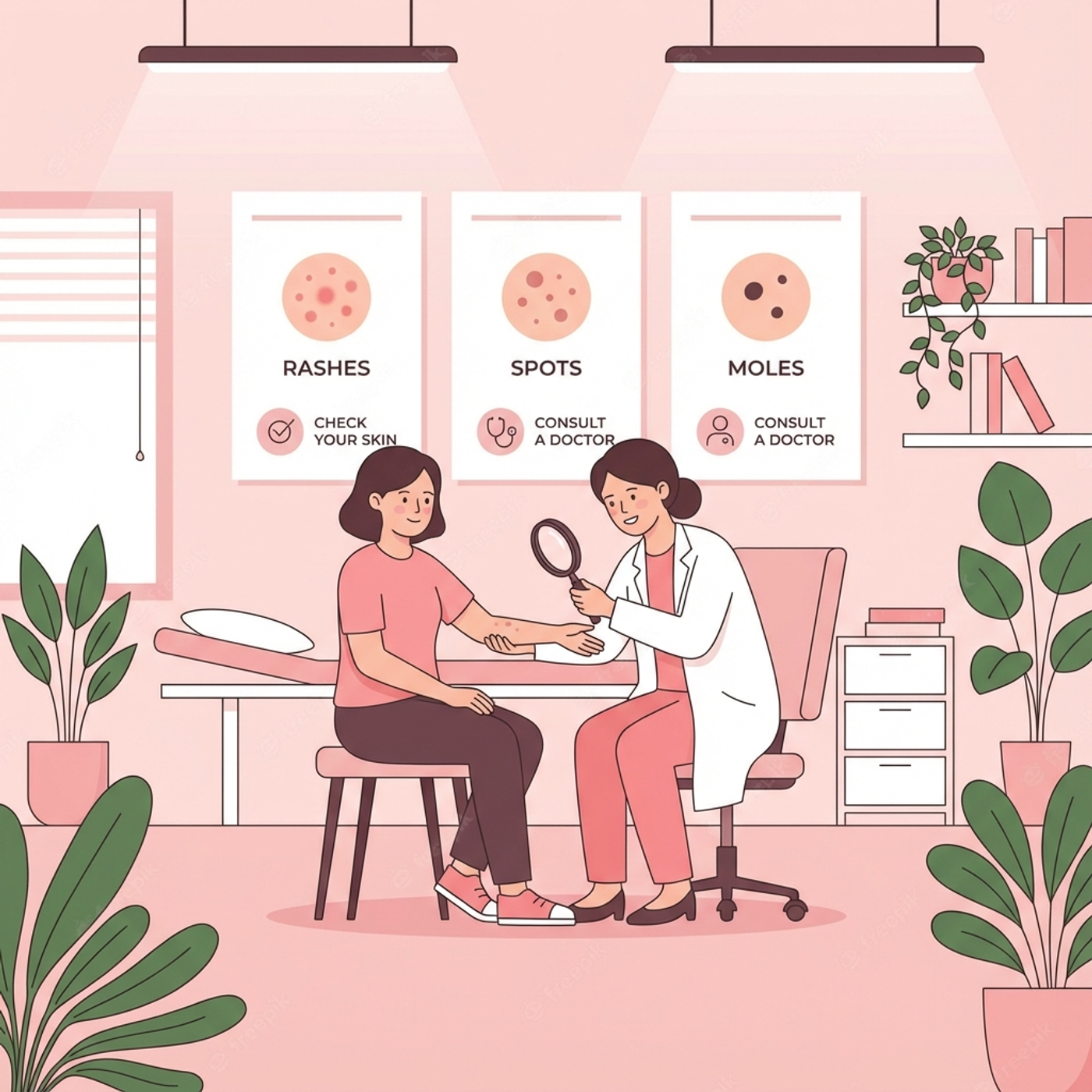Red Spot on Breast: Is it a Bug Bite, Rash, or Cancer? A Complete Guide

This article is part of our comprehensive guide on Benign Breast Disease.
Noticing a change in your breast skin can be alarming. You might see a red spot on breast no pain, a patch of irritated skin, or what looks like a red pimple on breast. Often, women describe these marks as looking like a “boobs bite” (bug bite) or a simple heat rash.
While most skin changes are harmless or treatable infections, some can be early warning signs of more serious conditions like Inflammatory Breast Cancer (IBC). This comprehensive guide will help you understand what your skin is telling you, distinguish between benign rashes and cancer symptoms, and know exactly when to see a doctor.
Is it Just a “Boobs Bite” or Something Else?
It is very common to mistake a serious symptom for something minor. Many women search for terms like “boobs bite” because the redness looks exactly like a mosquito or spider bite.
Common Harmless Causes of Red Spots
Before you panic, know that most red spots are benign. Here are the most common non-cancerous reasons for breast skin changes:
- Bug Bites: A single, itchy, raised red bump is likely a mosquito or ant bite. It usually heals within a few days.
- Folliculitis (Pimples): A red pimple on breast is often just a clogged hair follicle or sweat gland. The skin on the breast is sensitive and prone to acne, especially if you sweat during workouts.
- Allergic Reactions (Contact Dermatitis): New detergent, bra fabric, or lotion can cause itchy red patches.
- Intertrigo (Skin Rash Under Breast): Heat and moisture can cause a skin rash under breast folds. This is often fungal or bacterial, appearing as a red, raw, and itchy patch. It is common in hot weather or for women with larger breasts.
When Redness Means Infection: Mastitis and Abscesses
If the redness is accompanied by pain, warmth, and fever, it might be an infection.
- Mastitis: Common in breastfeeding women, but can happen to anyone. The breast becomes red, swollen, and painful.
- Breast Abscess: A pocket of pus that forms a painful lump under the skin.
When to Worry: Signs of Inflammatory Breast Cancer (IBC)
Inflammatory Breast Cancer (IBC) is a rare but aggressive form of cancer (accounting for 1-5% of all breast cancers). Unlike other cancers, it often does not form a lump. Instead, it blocks lymph vessels in the skin, causing visible changes.
Because it mimics a rash or infection, it is often misdiagnosed. Look out for these specific inflammatory breast cancer rash symptoms:
1. Rapid Change in Appearance
IBC develops quickly, often over weeks or months. If a “rash” appears suddenly and covers a third or more of your breast, pay attention.
2. Redness and Warmth
The breast may look pink, red, or purple. It might feel warm to the touch, similar to an infection, but antibiotics won’t clear it up.
3. Orange Peel Skin Breast (Peau d’orange)
This is a classic sign. The skin thickens and develops tiny pits, resembling the skin of an orange. This orange peel skin breast texture is caused by fluid buildup (edema) in the breast tissue.
4. Red Spot on Breast No Pain
Pain is not always a reliable symptom. You might see a red spot on breast no pain that spreads. However, some women do experience heaviness, burning, or aching.
5. Nipple Changes
The nipple may turn inward (invert) or look flattened.
Visualizing the Difference: Breast Rash Images vs. Cancer
While we cannot display clinical breast rash images here, understanding the visual difference is key:
- Benign Rash/Bite: Usually localized, itchy, and improves with creams or time. It has clear borders.
- IBC Rash: Often covers a large area, feels thick or heavy, and does not respond to topical treatments. The redness may not have a distinct edge.
Diagnostic Steps: Why You Need a Sonomammogram
If you have any persistent skin change on your breast, a physical exam is not enough. You need to see what is happening under the skin to rule out cancer.
A Sonomammogram (Breast Ultrasound + Mammogram) is the gold standard for evaluating these issues.
What Can a Sonomammogram Detect?
- Rule Out Infection: It can see if the redness is due to a fluid collection (abscess) which can be drained.
- Detect Skin Thickening: Ultrasound is excellent at showing the thickening of the skin layers, a hallmark of IBC.
- Find Hidden Lumps: Even if you don’t feel a lump, imaging can reveal underlying masses or swollen lymph nodes that are characteristic of cancer.
Dr. Gayathri Priyadharshinee emphasizes that any breast skin change lasting more than a week requires imaging. “Don’t wait for a lump,” she advises. “The skin is often the first messenger.”
Summary Checklist: When to See a Doctor
- You have a red spot on breast that hasn’t gone away after a week.
- The skin feels thick, heavy, or looks like an orange peel.
- You have a skin rash under breast that isn’t healing with hygiene changes.
- One breast looks significantly larger or warmer than the other.
- You were treated for mastitis/infection but it didn’t get better with antibiotics.
FAQ: Red Spots and Skin Changes on Breast
What does a breast cancer rash look like?
A breast cancer rash (associated with Inflammatory Breast Cancer) typically looks like a large area of redness or pinkness that covers a third or more of the breast. It often resembles an infection (mastitis) but does not improve with antibiotics. The skin may also look pitted like an orange peel.
Can a red spot on the breast be harmless?
Yes, absolutely. A single red spot on breast is most often a bug bite, a pimple, or a small skin infection. If it is small, itchy, and heals within a few days, it is likely benign.
Why do I have a red spot on my breast with no pain?
A red spot on breast no pain can be confusing. While infections usually hurt, Inflammatory Breast Cancer can sometimes present as painless redness or heaviness. However, painless spots can also be benign skin issues like cherry angiomas (small red moles). If it grows or persists, get it checked.
How do I treat a skin rash under my breast?
A skin rash under breast is usually caused by sweat and friction (intertrigo). Keep the area dry, use a barrier cream, and wear a supportive, breathable bra. If it doesn’t clear up, it might be a fungal infection requiring medication.
Is a red pimple on the breast a sign of cancer?
Rarely. A red pimple on breast is usually just folliculitis (an inflamed hair follicle) or a cyst. However, if a “pimple” doesn’t heal, bleeds, or grows into a larger lump, it should be examined by a doctor.
Conclusion
Don’t ignore a red spot on breast that sticks around. While it is likely just a bug bite or a red pimple on breast, it is always safer to be sure.
If you notice persistent redness, breast cancer rash symptoms, or skin changes that don’t improve, book a Sonomammogram immediately. Early detection is the key to treating both infections and serious conditions effectively.
To learn more about other breast conditions, read our main guide on Benign Breast Disease.
